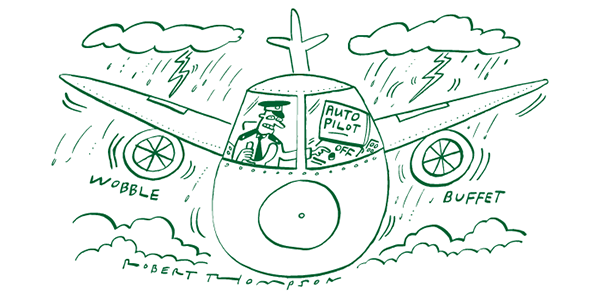Turbulence ahead' How to invest for inflation volatility

Inflation volatility is coming says Ruffer LLP’s investment director Duncan MacInnes.
Inflation is at a 40-year high. Given Ruffer has warned against rising inflation for some time, you might be forgiven for thinking we’ve cracked open the fancy (chocolate-covered) biscuits.
Unfortunately, we cannot rest upon our laurels. Because, ironically, now inflation is perceived as a problem, we can rest assured it will soon appear ‘Transitory’. But appearances can be deceptive.
Inflation volatility will take centre stage in the coming years. Increasing inflation volatility simply means inflation going up and down more sharply, more often. If inflation volatility is the future, you can be sure market turbulence won’t be far behind.
No single strategy will sail unscathed through this turbulence – portfolios will need to be dynamic and investors must be willing to adapt.

WAITING IN THE WINGS
So why has inflation been waiting in the wings for so long? Firstly, several deflationary D’s: debt, demographics, disruption, digitisation and détente’s globalisation. Secondly, the era of central bank inflation-targeting. Lastly, what our chief investment officer Henry Maxey calls ‘Refrigeration mode’ – the disinflationary feedback loop between China and the West. Rapid industrialisation, urbanisation and growth for China in exchange for consumer indulgences and keeping inflation and interest rates low and stable in the United States. This system had amplifiers: in financial markets quantitative traders and trend followers; in supply chains, the bullwhip effects of ‘Just in time’ systems which prioritised optimisation over resilience.
This shaped the economic and market landscape of the past few decades. It encouraged hyper-financialisation whereby the US has optimised its economy around asset prices. The result? Soaring c-suite pay, ballooning asset prices, rising inequality and corporate short-termism. Central bankers were complicit, openly targeting financial conditions as the transmission mechanism to the real economy.
Now this is all in flux. Powerful social reactions to wealth inequality, climate change and Cold War II (the containment of China’s geopolitical ambitions) have leapt to the top of the agenda. The shifting of these tectonic plates is inflationary. Wealth inequality calls for deficit-financed Universal Basic Income, ‘Stimmys’ (stimulus cheques), and debt forgiveness. The climate transition will be extraordinarily expensive – the International Energy Agency estimates achieving net zero by 2050 will require investment of around $4-5 trillion per annum (around 5-6% of global GDP) [1]. Chinese ambitions and pandemic realities have forced companies to move from ‘Just in time’ to ‘Just in case’, prioritising robustness and adding cost. The lines between monetary and fiscal stimulus have blurred and, as they coalesce, the overall policy mix becomes more inflationary – more like a magic money tree (MMT). This system has amplifiers too – technology – because social media can amplify inflationary trends and digital money enables depositors to exit fiat currency in a heartbeat.
"This fragility is evident in bond and equity markets, where duration (or sensitivity to the price of interest rates) is at an all-time high."
THE MARKET STAGE IS SET
Institutional constraints like benchmarking and Modern Portfolio Theory mean the asset management industry doesn’t have the tools to cope with this new environment. Conventional portfolios are vulnerable to the coming volatility.
In today’s financial system flows trump fundamentals. The drivers of flow (stimulus, past performance and passives) have been mutually reinforcing for at least a decade. The danger is that as liquidity conditions tighten the virtuous dynamic becomes a vicious one. Yet inflationary pressures necessitate the withdrawal of liquidity – rates are rising, quantitative easing is becoming quantitative tightening whilst energy prices, the US dollar and taxes are going up.
This fragility is evident in bond and equity markets, where duration (or sensitivity to the price of interest rates) is at an all-time high. In simple terms the amount of capital at risk if bond yields rise is as large as it has ever been.
INFLATION VOLATILITY IS NOT THE SAME AS HIGHER INFLATION
It is tempting to jump to position for the inflationary endgame. But the long run is a series of short runs and it is important to stay in the game. Investing for inflation volatility is not the same as investing for inflation. Investors must be careful not to make this mistake.
For the new regime, portfolios will need to be thoughtfully constructed. In a nutshell, swapping nominal assets for real assets, swapping the conventional for the unconventional; and resolving to be active and nimble rather than strategic will be crucial. Portfolios will need to be positioned for resilience, rather than optimisation. For regret minimisation rather than return maximisation.
Cash is an uncomfortable asset to hold in an inflationary world, but it is the essential quiver – storing the portfolio arrows needed to pick off opportunities as they arise. Investors will have to steer portfolios through the twists and turns of more abrupt economic and liquidity cycles whilst adapting to changing policy reaction functions.
Lastly, it is taken as gospel that timing markets is a fool’s errand. No wonder, given 80% of active managers have failed to beat their benchmarks in the past decade [2]. In this new world, stock pickers need to navigate two key challenges; firstly, risk premia will rise so equities should de-rate. Secondly, the distribution of returns will skew negative – imagine a game of snakes and ladders with twice as many snakes.
In this hyper-financialised world, it is difficult to know if the economy drives markets or the reverse, the relationship is tight and reflexive. Real interest rates can serve as a useful speedometer. We know, once real rates speed up, there is a higher probability of equity markets selling off and rotating out of growth stocks and into value stocks. Once real rates exceed the speed limit, the chances of an accident are high.

HOW DO YOU PROTECT YOUR PORTFOLIO?
One way is to position for a reversal in the fortunes of liquidity beneficiaries – like the high yield and investment grade credit market. Or by ‘getting short’ the zeitgeist. The sector most exposed to rising real interest rates looks to be the frothy end of the tech market. Winter is coming for liquidity, it is coming for retail punting, and it is coming for the equities which have gorged on the easy liquidity and social trends of the past decade. This is where much of our equity protection is focused. We are not resolute sceptics; the promise is real. But we think excess liquidity has brought the hopes and dreams of the future into the prices of the present.
Investing for inflation volatility represents the greatest challenge to portfolios for a generation. Protecting capital in periods of turbulence will be difficult but essential for investors seeking real, long-term growth in the value of their savings.
[1] International Energy Agency (May 2021), Net Zero by 2050: A roadmap for the global energy sector
[2] S&P Dow Jones Indices. Data to 31 Dec 2020
Past performance is not a guide to future performance. The value of investments and the income derived therefrom can decrease as well as increase and you may not get back the full amount originally invested. Ruffer performance is shown after deduction of all fees and management charges, and on the basis of income being reinvested. The value of overseas investments will be influenced by the rate of exchange.
The views expressed in this article are not intended as an offer or solicitation for the purchase or sale of any investment or financial instrument, including interests in any of Ruffer’s funds. The information contained in the article is fact based and does not constitute investment research, investment advice or a personal recommendation, and should not be used as the basis for any investment decision. References to specific securities are included for the purposes of illustration only and should not be construed as a recommendation to buy or sell these securities. This document does not take account of any potential investor’s investment objectives, particular needs or financial situation. This document reflects Ruffer’s opinions at the date of publication only, the opinions are subject to change without notice and Ruffer shall bear no responsibility for the opinions offered. Read the full disclaimer.
International Energy Agency (May 2021), Net Zero by 2050: A roadmap for the global energy sector
S&P Dow Jones Indices. Data to 31 Dec 2020






